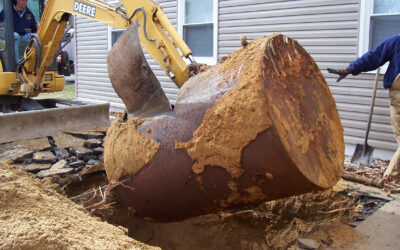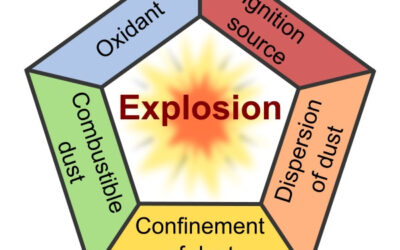Tips, Trends, & News
Hiring an Environmental Consultant Series: What to Consider When Choosing an Environmental Consultant…
As the owner/operator or responsible party, you must be aware that you are ultimately responsible for the investigation and cleanup of your release. Therefore extreme care should be used when selecting an environmental consultant, because the responsibility remains...
Protect Your Company From Being On The Kentucky Division of Enforcement’s Next Fiscal Report…
We want to share a document with you from the Department for Environmental Protection and Kentucky's Division of Enforcement because companies need to be informed about the Enforcement Branch to maintain the required environmental laws and understand how they are...
Cleanup Technologies – Air Stripping…
EPA’s Technology Innovation and Field Services Division developed A Citizen’s Guide Series to Cleanup Technologies. The guide is a set of 22 guides summarizing cleanup methods, designed to help Remedial Project Managers and Community Involvement Coordinators explain...
Cleanup Technologies – Activated Carbon Treatment…
EPA’s Technology Innovation and Field Services Division developed A Citizen’s Guide Series to Cleanup Technologies. The guide is a set of 22 guides summarizing cleanup methods, designed to help Remedial Project Managers and Community Involvement Coordinators explain...
Managing Environmental Risk is an Important Consideration for Investors Looking to Purchase Industrial Property…
Industrial properties are more likely to have environmental liabilities and the problems need to be identified and managed. Demand is high for high tech distribution facilities but most times they are being built on top of old manufacturing sites. Industrial property...
Tips for Closing Underground Storage Tanks (USTs)…
Many older underground storage tanks (USTs) need be be closed properly to protect human health and the environment. Contaminated ground water is usually the first sign that you have a problem with a UST. For the best tips on closing a UST we need to first know if you...
Emergency Response Plans: Your Continued Business Depends On It!…
Last year a Kansas refiner had to pay $2M in fines and reimbursement costs for a 2007 oil spill. Per the EPA, the company discharged about 2,145 barrels of crude oil, diesel fuel, and oil water from it's refinery into a nearby river during a flood on July 1, 2007. The...
Toxics Release Inventory (TRI) Reports and Why They Are So Important To File Correctly By July 1st Each Year…
The Toxics Release Inventory (TRI) Requirement EPA requires reporting of toxic chemical releases under EPCRA, and facilities that manufacture, process, or use toxic chemicals over certain quantities must file annual reports estimating the amounts released to the...
Prevent Your Company From Having Spill Prevention, Control, and Countermeasure (SPCC) Violations From the EPA…
SPCC is the abbreviation for the Spill Prevention, Control, and Countermeasure (SPCC) Rule. An EPA regulator from the Office of Emergency Management (OEM) recently revealed the most common SPCC violations he finds on field inspections. Typical Violations from All...
Learn to Avoid Dust Explosions That Can Cause Severe Structural Damage and Loss of Life…
A dust explosion is a very rapid burning of the dust while it's still suspended in the air, known as deflagration. If this happens in a confined enclosure (building, room, vessel, equipment) there may be an explosion. The dispersion of dust in particulate or finely...
Staying Compliant with the Toxic Substances Control Act (TSCA) When Transporting Polychlorinated Biphenyls (PCBs)…
Anyone who manufactures, imports, or exports hazardous chemicals is required by the EPA to comply with Toxic Substances Control Act (TSCA). Anyone transporting anything not on the TSCA list of chemicals must notify the EPA at least 90 days before producing or...
Tips on How to Identify and Minimize the Amount of Mold in Your Workplace…
Mold is a common, irritating and occasionally dangerous contaminant and it's presence can often be the cause of a variety of respiratory health issues, odors and even structural damage. The most important thing you can do is to pay attention to indoor air moisture...
Protect Your Company From Large Fines Using This EPCRA Compliance Checklist…
If your facility falls under Emergency Preparedness and Community Right-to-know Act (EPCRA) requirements, there’s more to do then just TRI reporting. Here’s a checklist to help you make sure you cover you bases with all the regulations. Have the requirements handy Do...
Above-ground Storage Tank (AST) Spill Prevention Tips that are Highly Recommended By the EPA…
Above-ground Storage Tanks (AST) are tanks that are aboveground, regardless of whether they are used for to store petroleum products, hazardous waste, or other hazardous material. AST's used for the store of petroleum products is regulated primarily under 40 CFR 112....
Preparation is the Key to Surviving an Inspection by the EPA or OSHA…
If a state or federal environmental agency came to your facilities today, would you be ready? If the answer is no, then you need to prepare yourself quickly. Environmental regulations are complex and reach far in to most operations. Even the most knowledgeable and...
Clean-up Tips for Mecury Spills…
When Mercury is spilled, the droplets can emit odorless vapors that are colorless and very toxic. These droplets can be lost in very small spaces and create major problems, no matter how small the spill. If you feel unsafe cleaning up Mercury or any other hazardous...
Creating an Asbestos Operations and Maintenance Program For Your Business…
Thousands of residential and commercial structures in the U.S. contain many different types of asbestos. Asbestos presents compliance problems home owners and commercial operations and maintenance personnel. This article is focusing on businesses. Staying on top of...
Be Careful That The EPA Judges Your Industrial Waste Recycling As Legitimate Recycling…
U.S. Environmental Protection Agency (EPA) promotes industrial hazardous waste recycling and has many concessions to do so. The EPA will not however make concessions on what constitutes legitimate recycling versus sham recycling. The 2008 DSW Rule established four...
Indoor Mold Contamination: How to Get Rid of Mold and What Causes Mold In the First Place…
Moisture in buildings and common structural problems allow mold to exist indoors. Mold creates and indoor problem that is unhealthy for it's inhabitants. So make sure to find areas where mold is most likely to occur and if you see a problem, fix it quickly before is...
OSHA NEWS: Site-Specific Inspections Targeting Directive For 2014…
The OSHA SST-14 Program is and effort to place its enforcement resources in workplaces that have the highest rates of injuries and illnesses. They are targeting high-hazard, non-construction workplaces that have 20 or more workers based on last year’s OSHA Data...
11 Compliance Tips for Containers That Hold Hazardous Waste…
Hazardous waste containers are the most common unit used to store and transport hazardous waste because they are relatively cheap and easy to handle compared to tanks and surface impoundments. Also, containers are a good option for hazardous waste handlers who want to...
The Toxic Substances Control Act (TSCA): Applicable to Companies That Manufacture, Import, or Export Hazardous Chemicals…
The Toxic Substances Control Act (TSCA) requires that anyone who wants to manufacture or import a chemical not listed on the TSCA list of chemicals must notify the EPA at least 90 days before producing or importing the new chemical substance. TSCA also imposes...
A Quick Guide for Universal Waste Handlers to Stay On Top of Requirements…
Below is an easy-to-read chart that identifies the regulations that affect each generator type... Small Quantity Handler of Universal Waste Large Quantity Handler of Universal Waste Universal Waste Transporter Universal Waste Designation Facilities Prohibitions...
What Are the Top Environmental Violations? See What the EPA Says…
The Environmental Protection Agency (EPA) performs its mission of protecting human health and the environment by providing research, monitoring our environment, as well as setting and enforcing environmental standards. The EPA performs inspections throughout a variety...
Cross-Agency Enforcement: Sometimes Inspections by the EPA Can Lead to Inspections by OSHA and Vice Versa!…
Penalties and compliance upgrades can get really costly when an inspection by the Occupational Safety and Health Administration (OSHA) leads to and inspection by the Environmental Protection Agency (EPA) or the other way around. Many regulations by the EPA and OSHA...
Identifying Amputation Hazards In The Work Place…
Most accidents that result in amputation are preventable but when they happen are severe and often disabling. All it takes is a moment of inattention and you can get caught in machinery that amputates a limb. 5,260 nonfatal amputations were reported in the United...
A Checklist of Hazmat Operations for Companies that Transport Hazardous Materials…
The U.S. Department of Transportation (DOT), through its hazardous material regulations (HMRs), specifies requirements for the safe transportation of hazardous materials in commerce by rail, aircraft, vessel, and motor vehicle. DOT has general requirements for the...
Requirements You Need to Make Sure Are In Your Hazardous Waste Operations and Emergency Response (HAZWOPER) Plan…
The Hazardous Waste Operations and Emergency Response (HAZWOPER) Health and Safety Plan (HASP) applies to cleanup operations required by government agencies at uncontrolled hazardous waste sites, corrective actions involving cleanup at Resource Conservation and...
Tips on Conducting a Smooth Inspection for Your Business…
Facility operators don't have much time to prepare for a inspection after a notice arrives. It's best to talk to Raleigh, NC business attorney and have procedures in place to handle how to handle an inspection. Most facility operators know their inspectors and have...
Beware: Many Older Products and Equipment Use or Contain Mercury and the EPA Can Hold You Responsible…
Mercury is one of the most dangerous hazardous contaminants in our environment and can be found in the air, soil, and water just about anywhere on earth due to it's use in products and equipment before it was recognized and regulated as a toxic heavy metal. The use of...
K-12 Schools: A List of Potential Federal Environmental Regulation Violations…
Environmental Risk Management has been keeping Ohio, Kentucky, and Indiana schools clean, safe, and compliant with federal environmental regulations for years. Below is a list of some of the most common laws that apply to K–12 schools. It's not the full list but a...
Tips on Responding to a Notice of Violation (NOV) or Enforcement Order…
If your facility is found to be out-of-compliance, use the following tips... Make Sure to have a procedure in place to respond to a Notice of Violation (NOV), an enforcement order, etc. The person responsible for responding needs to be given a copy of the NOV as soon...
Are Your Polychlorinated Biphenyls (PCBs) Properly Marked? Fines Can Be Large!…
PCB labeling Requirements If items were not originally labeled by their manufacturer, the owner must label items that may contain PCBs. Standard PCB labels are square and come in 1-in. increments from 2 in. x 2 in. to 6 in. x 6 in. If the standard PCB label is too...
Vapor Encroachment in Kentucky/Ohio Considered a Real Environmental Risk…
Buyers and Sellers of Commercial Real Estate Should Know That Vapor Encroachment in Kentucky and Ohio is Considered a Real Environmental Risk What is Vapor Encroachment? Vapor encroachment is a source of contamination and is deemed an environmental risk by the United...
GHS Employee Training Kentucky, Ohio, and Indiana – Now Available Through Environmental Risk Management…
What is GHS The GHS is an acronym for The Globally Harmonized System of Classification and Labeling of Chemicals. The GHS is a system for standardizing and harmonizing the classification and labeling of chemicals. It is a comprehensive approach to... Defining health,...
Do You Have Waste That Has One of the EPA’s 4 Hazardous Properties? Is It On a Toxic Waste List? See How the EPA Breaks It Down So You Aren’t Surprised…
Determining If Waste is a Hazardous Waste The EPA's RCRA regulations establish two ways to classify solid wastes as a hazardous waste. The first way is that if the waste has ignitability, corrosivity, reactivity, or toxicity, it is determined to be a hazardous waste....
Do You Have Hazardous Waste? Should You Be Using A Containment Building?…
What is a Containment Building? Hazardous Waste Containment buildings are designed and constructed of man-made materials with the strength to be self-supporting. They have walls, a floor, and a roof and are waste management units similar to tanks, containers, and drip...
A Quick List of OSHA Requirements That You Should Know About…
In keeping with our goal to ensure our current and future clients have compliance within the complex maze of environmental and safety regulations we want to provide the following list of OSHA requirements that need compliance. Please let us know if you need assistance...
New HUD Policy Effects Buyers, Sellers, Owners of Multifamily Housing. Get the Facts!…
In June of 2013, the U.S. Department of Housing and Urban Development (HUD) Office of Multifamily Housing new policy requires radon testing and, if applicable, mitigation for most new FHA-insured construction, conversion and substantial rehabilitation projects, as...
Property Contamination and How It Can Impact Lenders…
Past property contamination can result in a lender having added costs, added liabilities, foreclosure possibles, or a major loss in property value. Make Sure To Do the Proper Research Up Front There are risks for lenders who can be surprised by a property's unknown...
The July 1st Toxic Release Inventory Reporting Deadline Is Approaching
The EPA established the Toxic Release Inventory (TRI) in 1986 by Section 313 of the Emergency Planning and Community Right-to-Know Act and later expanded by the Pollution Prevention Act of 1990. The goal of TRI is to provide communities with information about toxic...
Working with Petroleum Oils? The EPA’s Spill Prevention, Control, and Countermeasure (SPCC) regulation affects over 630,000 facilities… Is Yours One of Them?
The Spill Prevention, Control, and Countermeasure (SPCC) rule includes requirements for oil spill prevention, preparedness, and response to prevent oil discharges to navigable waters and adjoining shorelines. The rule requires specific facilities to prepare, amend,...
What You Need to Know About The EPA’s Lead Renovation, Repair and Painting Rule
Did you know there is a EPA lead-based paint Renovation, Repair and Painting Rule commonly known as RRP. The EPA is stepping up their vigilance to the rule and fined 16 firms for violation last November. RRP is EPA’s enforcement program is to...
The Big Report on Your Annual Hazardous Chemical Inventory Reporting
There should never be anything left to chance regarding the usage and care of hazardous chemicals in your business. That is why EPA requires an annual report your chemical inventory. Below is a list to make performing this important task as less hazardous as...
Does Your Company Claim To Recycle Hazardous Waste? If So, Are You Avoiding Speculative Accumulation? Find Out Inside…
The Resource Conservation and Recovery Act (RCRA) regulations include many provisions under which hazardous wastes can be legitimately recycled. So when you recycle hazardous waste, you become exempt from the following hazardous waste regulations. For more on...
Will Renovating Your Home, Office or Business Make People Sick and Expose You to Major Legal Liabilities?
A major consideration when renovating any structure is the risk of disturbing building materials that may contain toxic environmental and health/safety hazards such as asbestos, lead paint, mold and PCBs. Test the Areas First When you renovate always be certain to...
Do You Have Potentially Toxic PCBs in Your Caulk?
Do you know if you have potentially toxic PCBs in your caulk? The EPA recently reported PCBs have been found in high levels in building caulk. PCBs are man-made toxic chemicals which can affect the immune system, reproductive system, nervous system, and endocrine...
When the EPA Mentions “Waters of the United States,” What Do They Mean?
The Clean Water Act (CWA) defines "waters of the United States" as it applies to the jurisdictional limits of the authority of the Army Corps of Engineers (Corps). It stipulates the policy, practices, and procedures to be used in determining the extent of jurisdiction...









